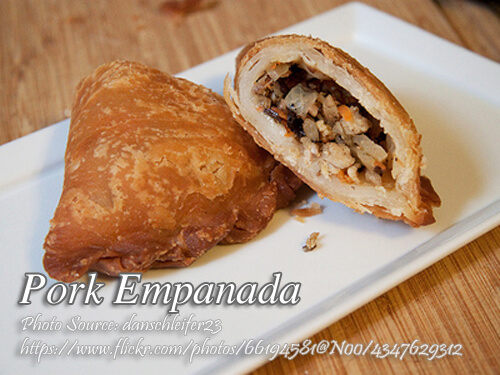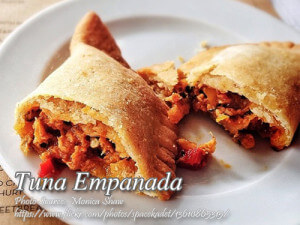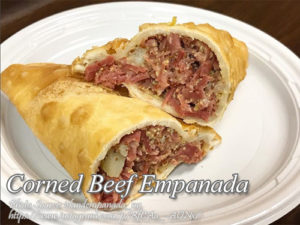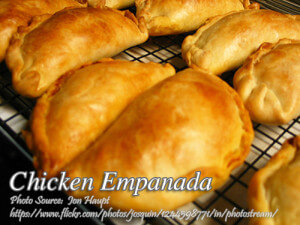Pork empanada recipe has ground pork and vegetables filling. Empanada has it’s origin from Spain and it is one of the many Filipino cuisine with Hispanic influence. This is actually a type of ground pork turnover and has many variations with regard to the filling. Although a little tedious when cooking this type of food, it is not very hard.
The only hard part in preparing the empanada is making the dough and wrapping the filling with the dough. But with a little practice I’m sure you can make a perfect empanada. Frying is the most convenient way of cooking this empanada but you can also bake it if you prefer it with no grease.
Pork Empanada: A Delicious Taste of Tradition
There’s something about biting into a warm, crispy, and savory pork empanada that transports me right back to childhood memories of family gatherings and simple afternoons spent in my Lola’s kitchen. The smell of golden pastry filled with perfectly seasoned ground pork and tender vegetables would fill the air, making it impossible not to hover nearby, waiting for the first batch to cool enough to devour. Pork empanadas are a beloved snack in Filipino cuisine, influenced heavily by our Spanish heritage, yet they’ve found a special place in our hearts and palates, infused with our local flavors and cooking traditions.
A Heritage Rich in Flavor
Empanadas trace their origins to Spain, where they were made to enclose various fillings in a flaky, pastry crust, providing a convenient and portable meal. When Spanish colonizers brought these turnovers to the Philippines, locals put their own spin on the dish. In our version, pork empanada is often generously stuffed with ground pork, potatoes, carrots, peas, and a hint of sweetness from raisins. Each bite is an explosion of flavors and textures, balancing savory and sweet, all wrapped up in a buttery, crispy crust.
My Uncle Tony would always say that the key to a delicious empanada lies in the filling-to-crust ratio. He used to joke, “An empanada is like life. It’s all about balance.” He wasn’t wrong. The filling has to be flavorful but not overpowering, with just enough dough to hold everything together without being too heavy.
Preparing the Pork Empanada Filling
The filling of a pork empanada is all about building layers of flavor. Start by heating oil in a large skillet and sautéing the aromatic duo: garlic and onions. This initial step isn’t just about aroma; it’s foundational to adding depth to the dish. My Tita Carmen always insisted on this technique, saying, “Never rush your onions, or your empanada will miss the mark.”
Next comes the ground pork, which needs to be cooked thoroughly, absorbing the savory notes of salt, pepper, and granulated seasoning. The addition of finely diced potatoes and carrots introduces a delightful texture, soft yet with a slight bite, giving the filling some body. As the mixture simmers with a bit of water, it not only cooks evenly but also becomes tender, with flavors melding beautifully. It’s important to stir occasionally to prevent sticking—a technique my cousin Miguel once shared, along with the tale of how he’d burn empanada fillings as a rookie cook, leaving everyone laughing but hungry.
For that signature Filipino touch, throw in peas, chopped bell peppers, and a handful of sweet raisins. The raisins might seem unexpected, but they add a pop of sweetness that perfectly complements the savory filling. Even the most skeptical among us—like my younger brother Carlo, who initially scrunched up his nose at the sight of raisins—ended up loving this combination. Adjust the seasonings to your liking, making sure the filling is well-rounded before letting it cool completely.
Crafting the Perfect Pastry Dough
While the filling gets all the love, the dough is the unsung hero of a truly unforgettable pork empanada. Making pastry dough from scratch can seem intimidating, but with a few tips, even beginners can master it. The secret? Cold ingredients. By using cold butter and water, you ensure a flaky and tender crust.
Mixing the dry ingredients—flour, sugar, baking powder, and salt—requires a light touch. Once you add the pieces of cold butter, use your hands to combine until the mixture resembles coarse crumbs. My Auntie Lina swore by this, claiming it made all the difference. Kneading just enough to bring the dough together ensures it remains tender rather than tough.
Once formed into balls, the dough needs a brief rest in the refrigerator. This allows the gluten to relax and makes the dough easier to roll out later. After chilling, roll each ball on a floured surface until it’s thin yet sturdy enough to hold a generous amount of filling.
Sealing and Cooking: The Final Steps
Folding and sealing each pork empanada is almost therapeutic, a repetitive rhythm that brings a sense of accomplishment. You can crimp the edges with your fingers or use a fork for a rustic look. My cousin Andrea loved to seal them with elaborate, decorative crimps, claiming that “the prettier the empanada, the tastier it is.”
When it’s time to cook, frying is the way to go if you crave that crisp, golden crust. Deep frying may seem indulgent, but it ensures the dough cooks evenly, forming a satisfying crunch with every bite. Place the fried turnovers on paper towels to drain excess oil, and don’t forget to taste-test one (or two) while they’re still warm.
For a healthier option, baking the empanadas works beautifully as well. While they won’t have quite the same crunch, they make up for it with a lighter, less greasy feel. Either way, you’ll be left with a delicious snack perfect for sharing—or savoring alone, as I sometimes do when I’m feeling nostalgic.
A Bite of Nostalgia
Every time I make pork empanadas, I think of family and all the laughter and stories shared over this simple yet labor-of-love snack. Whether you’re a seasoned cook or just starting out, making this empanada is a rewarding experience. The process may be a bit tedious, but the end result is undeniably worth it—a dish rich in flavor, history, and the warmth of cherished memories. So gather your ingredients, invite some friends or family to join in the fun, and enjoy creating this Filipino classic that has been a beloved part of our cuisine for generations.
How To Make Pork Empanada
Ingredients
For the pastry:
- 6 cups All-purpose flour
- 1/2 cup white sugar
- 1 tsp. baking powder
- 1 tsp. fine salt
- 6 Tbsp. shortening or butter
- 1 cup cold water
- cooking oil for frying
For the filling:
- 4 Tbsp. cooking oil
- 4 cloves garlic minced
- 2 white onions minced
- 1 kilo ground pork
- 2 tsp. ganulated seasoning e.g. Magic Sarap
- 1/2 tsp. fine salt
- 1/8 tsp. ground blackpepper
- 1/2 cup raisins
- 1 cup green peas
- 2 medium size potatoes cut into small cubes
- 1 pc carrot cut into small cubes
- 1 red bell pepper finely chopped
- 1/2 cup water
- 3 tsp. sugar
Instructions
To make the pork filling:
- In a large skillet, heat oil and saute garlic and onions until onions are cooked.
- Add in ground pork and stir cook for a few minutes.
- Then add salt, pepper and granulated seasoning.
- Stir cook for 1 minute then add potatoes, carrots and water.
- Simmer for at least 5 minutes and stir cook to prevent the meat from sticking on the pan and to cook it evenly.
- Add in the raisins, peas, bell peppers and sugar and adjust the seasonings.
- Cook for 2 minutes more or until the liquid has almost evaporated. Set aside to cool.
To make the pastry dough:
- Combine flour, white sugar, baking powder and salt. Mix the dry ingredients using a wire whisk.
- Add in the pieces of butter to the dry ingredients and mix them until the butter is well mixed with the flour mixture.
- Add in the water and knead until the mixture turns into a smooth dough.
- Grab about 4 tablespoon of dough and form it into a ball. Do the same for the rest of the dough.
- Put in the refrigerator for about 20 minutes. In the meantime prepare a clean surface, like a chopping board, and dust with flour.
- Get a piece of dough and press it on the surface of the chopping board until it become flat.
- Using a rolling pin, flatten it further until thickness become at least half a centimeter thick.
- Place 4 tablespoon of filling on the center of the flattened dough.
- Fold the dough and seal the round edges by crimping or folding it.
- You can also seal the edges by pressing a fork. Do the same for the rest of the dough and filling.
- In a deep frying pan, heat oil about 3 cups and deep fry the empanadas for 3 to 5 minutes or until the empanadas turns golden brown.
- Place the empanadas in a bowl lined with paper towels to drain excess oil, Then transfer to a plate and serve.
Notes
Cooking Tips:
Keep Your Ingredients Cold for Flaky Dough
To achieve a flaky and tender empanada crust, always use cold butter and ice-cold water. Cold ingredients prevent the butter from melting prematurely, which helps create pockets of steam while baking or frying, resulting in a light, crispy texture. Chill the dough in the refrigerator before rolling it out to make it easier to handle and shape.Season Generously and Taste the Filling
The flavor of your empanada largely depends on the seasoning of the filling, so don’t be afraid to season generously. As the filling cooks, taste and adjust the seasonings, balancing the savory, salty, and slightly sweet flavors. Remember, a well-seasoned filling ensures that every bite of the empanada is full of deliciousness.Seal the Edges Tightly to Prevent Leaks
To keep the filling from spilling out during cooking, make sure to seal the edges of the dough tightly. You can crimp the edges with a fork or create a decorative fold, pressing firmly to ensure the dough sticks together. A secure seal not only keeps the filling intact but also adds a beautiful, professional look to your empanadas.






is it normal for the empanada dough to be uncrispy once it cools down?
Hi JoyniRoned, I think its normal for the empanada to lessen its crispness once it cools down.
Hi Dang, you are welcome!
Thanks for the recipes! 👌👌
I always refer to your site for Filipino recipes. Thanks you!!
Hi Patty, thanks or visiting and hope you will visit often!
sir do you have a compilation of your recipes?
Hi Krizza, I only have a ebook but very few recipes in it. You can download it by subscribing on my email list. Just scroll above and you will find the link.
I don’t actually know where the vinegar for? in your pastry ingredient.
Hi Helen, I corrected the recipe already and thanks for your feedback.